King Charles enters Senatepublished at 15:44 BST 27 MayBreaking
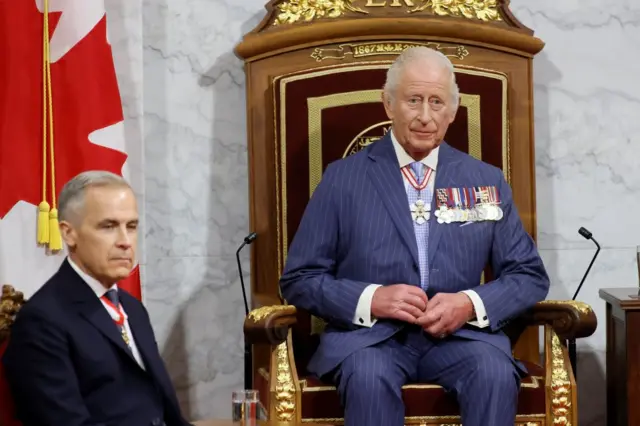 Image source, Reuters
Image source, ReutersKing Charles is now inside the Senate chamber and is sitting on the throne.
The throne speech is minutes away, so stay with us.
King Charles has given the throne speech to mark the opening session of Canada's parliament
In comments written by Prime Minister Mark Carney's government, he speaks of a "new economic and security relationship between Canada and the US, rooted in mutual respect" that will benefit "both sovereign nations"
He also says the Canadian government "will unleash a new era of growth that will ensure we don't just survive ongoing trade wars, but emerge from them stronger than ever"
And concluding, he says: "As the anthem reminds us: The True North is indeed strong and free" - a remark met with applause
The King was invited by Carney, who said the visit "underscores the sovereignty of our country" - a reference to Donald Trump's claims about making Canada the 51st US state
The speech was last read by a head of state - the King's mother, Queen Elizabeth II - in 1977
Edited by Caitlin Wilson and Jacqueline Howard, with Nadine Yousif, Gary O'Donoghue, and Sean Coughlan in Ottawa
 Image source, Reuters
Image source, ReutersKing Charles is now inside the Senate chamber and is sitting on the throne.
The throne speech is minutes away, so stay with us.
Pomp and pageantry continues as the Black Rod enters the Senate.
The Black Rod leads the Speaker’s Parade that opens and closes every sitting of the Senate.
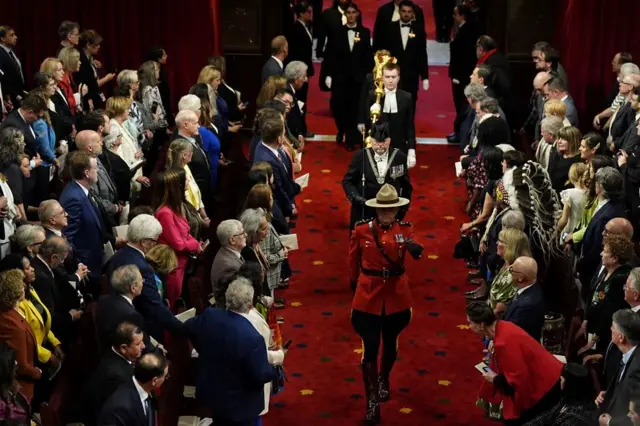 Image source, PA Media
Image source, PA MediaThe Canadian Senate is packed as attendees wait for King Charles to enter.
When he arrives, he is due read the speech written by the government in English and French, Canada's two official languages.
 Image source, Reuters
Image source, ReutersThe Senate is full of people waiting to hear the King deliver the throne speech
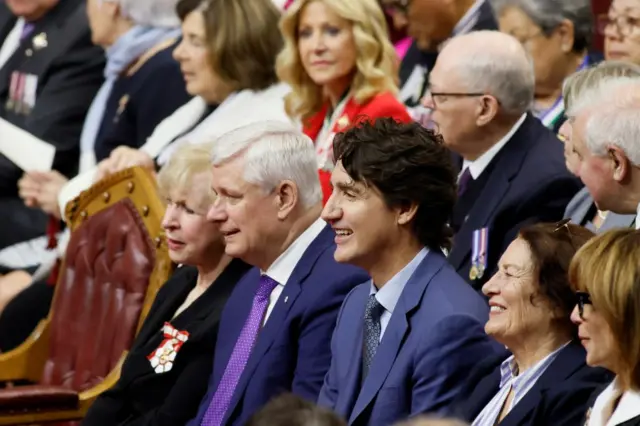 Image source, Reuters
Image source, ReutersCanada's former prime ministers Justin Trudeau and Stephen Harper are sitting side-by-side
 Nadine Yousif
Nadine Yousif
Reporting from Ottawa
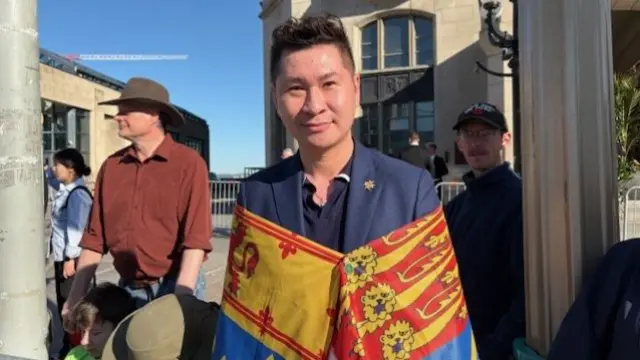
While we await the start of the throne speech, we can continue to bring you some stories from people who have travelled to be here today.
Edward Wang flew in from his home across the country in Vancouver to see the King and Queen. He has been front and centre at the procession line since 06:30 local time.
“When the King is coming all the way here to help Canadians in our time of need, I just felt as a Canadian that I had to be here to cheer and support him on,” Wang tells me.
He was born in Beijing, China and moved to Canada at a young age. He became a fan of the monarchy when he started to learn about Canada’s history, and he credits the Crown for being “the strong backbone” of the country’s stable democracy.
Wang adds that this particular visit by the King, amid Canada’s strained relationship with the US, underscores that.
The visit, he says, “shows that our Royal family are not fair-weather friends”.
“They are here to support us in good times and in bad, and they’re willing to drop everything just to come here.”
 Nadine Yousif
Nadine Yousif
Reporting from Ottawa
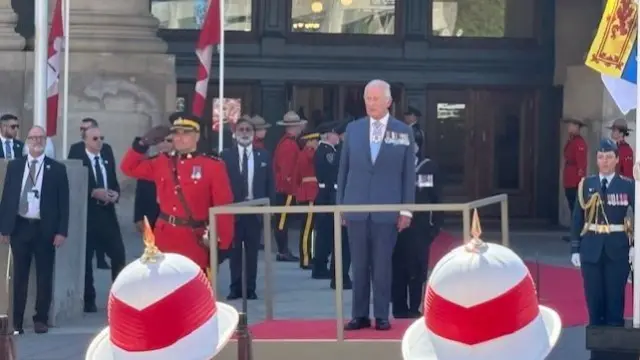
The King and Queen arrived moments ago to the front doors of Canada’s Senate. The crowd here cheers and chants “God Save the King”.
His arrival is followed by the firing of cannons several times - 21 to be exact - as part of the ceremonial 21-gun salute.
The King then gives a Royal Salute to the members of the Royal Canadian Regiment who have assembled to greet him, before standing for Canada’s national anthem.
All of this is part of the ceremony surrounding the King’s arrival ahead of the big throne speech, which is scheduled to begin shortly.
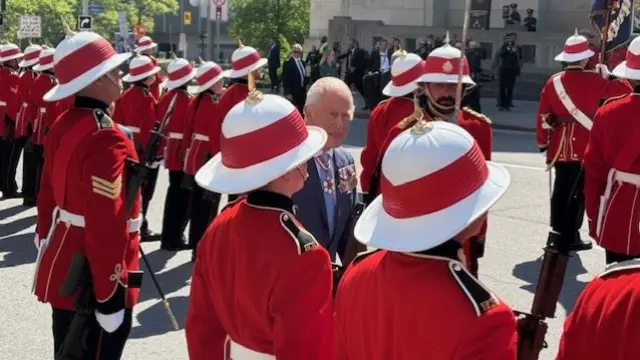
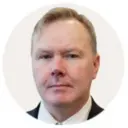 Sean Coughlan
Sean Coughlan
Royal correspondent, reporting from Ottawa
After all the chatting and taking selfies, the parliamentarians are hushed as the ceremony begins.
There are red robes in view and a prayer. But there’s another fashion point under discussion - Justin Trudeau’s green trainers.
It’s a relaxed country after all.
 Image source, PA Media
Image source, PA MediaThe King has arrived inside the Canadian parliament building and is now greeting officials.
First Nation group Ottawa River Singers is now performing on the drums in front of King Charles and Canadian Prime Minister Mark Carney.
As the King greets and speaks with Canadian soldiers, members of the public who have lined up can be heard spontaneously shouting: God Save the King!
King Charles has arrived at the Senate and he is greeted by a gun salute.
He is also chatting with members of the Canadian Armed Forces.

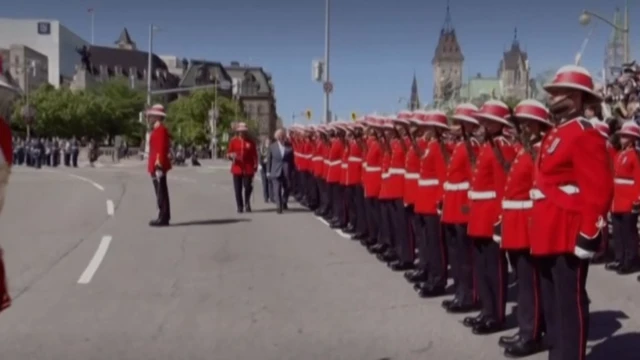
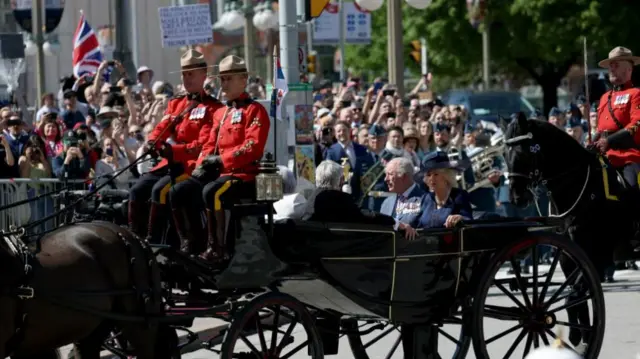 Image source, Reuters
Image source, ReutersWe're now seeing the Royal Canadian Mounted Police escort the King and Queen to the Canadian parliament.
The royals are travelling in an open-topped coach.
Remember, you can watch along via the watch live button at the top of this page.
Prime Minister Mark Carney and his wife Diana Fox Carney have arrived at the Senate for the speech
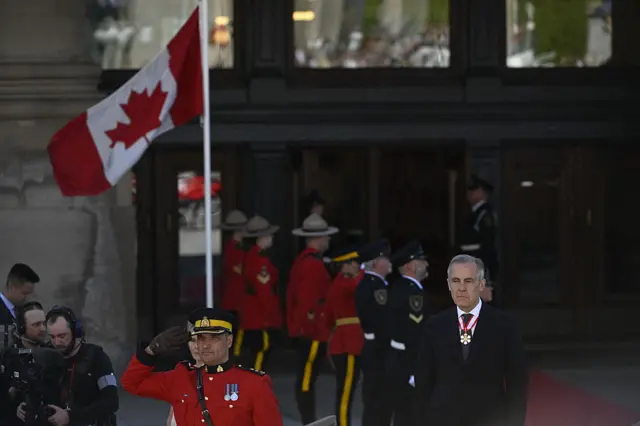 Image source, AFP via Getty Images
Image source, AFP via Getty Images Nadine Yousif
Nadine Yousif
North America reporter

Hello and good morning from Ottawa, Canada's capital. It is a sunny day today and many spectators have already gathered along the city’s main road leading up to parliament to get a good view of the Royal procession.
Many are waving Canadian flags. Some have been here waiting since early in the morning.
We’re starting to see some of the ceremonial aspects of today take shape ahead of the King and Queen’s arrival to the Senate, where the King is set to deliver the Speech from the Throne.
A 100-person guard of honour from the 3rd Battalion, Royal Canadian Regiment have assembled outside the Senate to give the King and Queen the Royal Salute once they arrive.
They were met with cheers from the crowd.

While it is not unprecedented for the Throne Speech to be read by the head of state, the last time this happened was , externalnearly 50 years ago, external, in October 1977, by Queen Elizabeth II.
That was only the second time the head of state had read the Throne Speech in Canada’s history - the first was in 1957, also by Queen Elizabeth II.
In 1982, Canada passed the Constitution Act, which gave the country the power to decide its own laws without input from the British monarchy.
The King’s speech will mark the first time since the passing of that act that a monarch has delivered the Throne Speech.
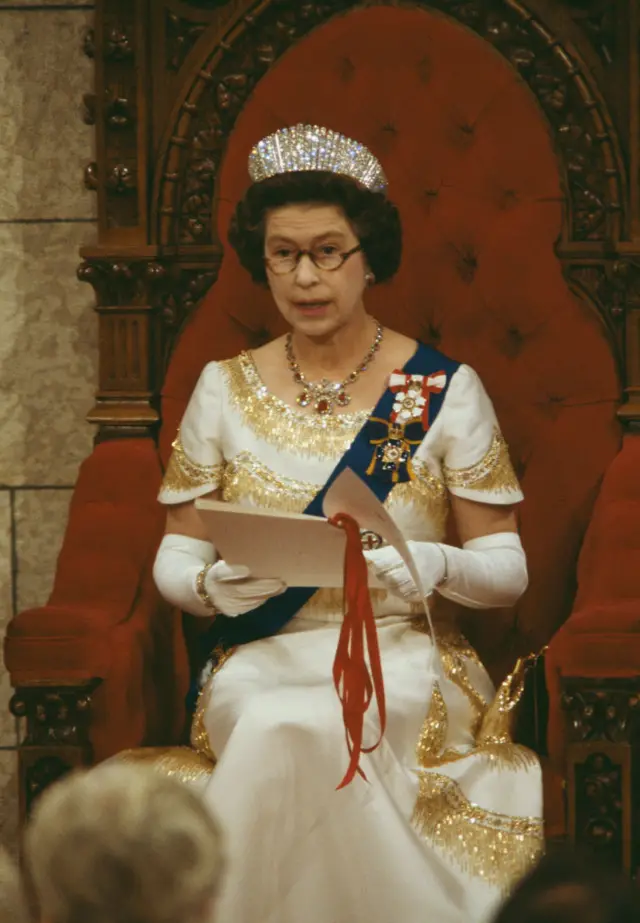 Image source, Getty Images
Image source, Getty ImagesQueen Elizabeth reading the Throne Speech during her Silver Jubilee Tour in 1977
 Image source, Getty Images
Image source, Getty ImagesAt the centre of Canada’s parliament buildings, there’s the Peace Tower - a clock tower and bell, which flies the Canadian flag.
But when King Charles arrives at parliament for the ceremony, the Canadian flag is replaced with his own flag, known as the Royal Standard.
The same happens when the Governor General leads the ceremony.
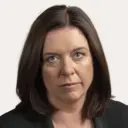 Daniela Relph
Daniela Relph
Senior royal correspondent, reporting from Ottawa
This has been a flying visit by royal standards – less that 24 hours on the ground for the King and Queen. After a community event and political meetings yesterday, today will be dominated by the Opening of the Parliament and the pomp and ceremony that comes with it.
The King and Queen’s final official engagement before leaving to return to the UK will be at the National War Memorial in Ottawa.
The King will lay a wreath and the Last Post will be played by a bugler. It will be an emotive and reflective end to the royal visit.
 Sean Coughlan
Sean Coughlan
Royal correspondent, reporting from Ottawa
A theme of the visit has been the King wanting to engage with Canada's Indigenous communities.
And there are many representatives of those groups visible at the opening of Parliament, with a show of traditional outfits and headdresses.
In the order of ceremony, the site on which Parliament is gathering is described as the "unceded territory" of the Algonquin people.
Near to where the King will be making his address is a "qulliq", a traditional Inuit oil lamp.
 Image source, BBC / Sean Coughlan
Image source, BBC / Sean Coughlan Image source, EPA
Image source, EPAMark Carney was sworn in as Canada’s prime minister in March after the resignation of his predecessor, the former leader of the Liberal Party Justin Trudeau.
He then won a snap election last month, allowing him to continue in the role. The 60-year-old was born in the remote northern town of Fort Smith, in the Northwest Territories.
The son of a high school principal, he went to Harvard University on a scholarship where he played the most Canadian of sports: ice hockey.
He went on to have an extensive career in the banking sector - he was the first non-British person to become the governor of the Bank of England in its more than 300-year history.
Prior to that, he steered his home country through the 2008 financial crash as the governor of the Bank of Canada.
Unlike most PM-hopefuls, Carney had never held political office before his election as Liberal Party leader. The Liberals had reportedly courted him for a decade, but until recently he had brushed off the idea.
"Why don't I become a circus clown?" he once told a reporter in 2012.
The King is delivering the speech today on Carney's invitation.
A Speech from the Throne opens every new session in Canada's parliament - in fact, neither the Senate nor the House of Commons can conduct public business until it’s been delivered.
So what is it? It’s a speech that sets out the government’s direction and goals for the session, and is usually read by Canada’s governor general, who is the King’s representative in Canada.
This time - for the third time in Canada’s history - it will be read by the country’s head of state, King Charles. Queen Elizabeth II did it twice, once in 1957 and once in 1977.
It’s called the throne speech because it is delivered from the monarch’s throne in the Senate, where it represents the symbolic presence of the monarch in Canada.
 Sean Coughlan
Sean Coughlan
Royal correspondent, reporting from Ottawa
The build-up to today's speech has been focused on Canada's tensions with Donald Trump, but that’s quite likely to be one name that we’ll never hear mentioned by the King.
There might be an assumption that the whole trip is a coded message about Canadian sovereignty, but the speech is likely to be presented in diplomatic language. It might be implying "hands off" Canada, but it’s likely to be phrased in a way that’s diplomatic and doesn’t inflame the situation.
However, the speech is being written by the Canadian government, so they'll want to make their point about rejecting any take over bid by the United States. And there's likely to be an introduction to the speech by the King that allows him more scope for personal thoughts.
The speech is expected to last about 25 minutes, and much of it will be about the everyday stuff of government, with an overview of the goals of Mark Carney’s new administration.
But the interest will be in decoding the lines about sovereignty and Canada not being for sale, even if it's part of a diplomatic balancing act.